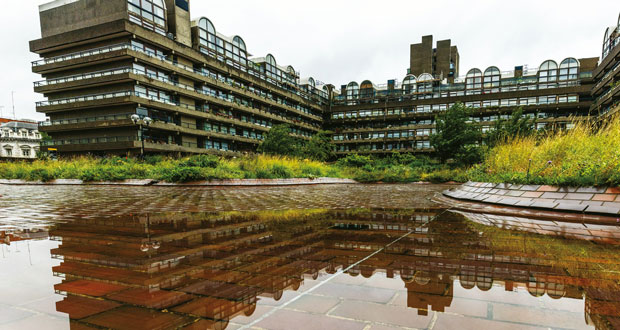 Karl Cundill, Joint Managing Director at LitmusFM, looks at proactive maintenance plans that can be implemented to reduce the risk of grounds flooding
Karl Cundill, Joint Managing Director at LitmusFM, looks at proactive maintenance plans that can be implemented to reduce the risk of grounds flooding
The UK is experiencing increased rainfall, with the past 18 months being the wettest England has seen since records began in 1836. Many climate scientists have warned that this is becoming the norm, with climate change exacerbating weather events, creating both warmer and wetter conditions. As climate change results in more frequent, and heavier, rainfall and drier summers, this brings many new challenges for grounds maintenance.
Significant levels of rainfall and flooding have a detrimental impact on grounds and landscaped areas, with garden plants dying as a result, sporting pitches becoming unusable, outdoor seating areas becoming waterlogged and school grounds having to close completely – the list goes on. Waterlogged outdoor areas, along with ill-maintained gutters, downpipes and drainage systems, increase the risk of water levels rising to the point they potentially flood adjoining buildings.
For FMs this poses new challenges, and the need for more robust, long term grounds maintenance plans to help reduce the risk of flooding and damage.
PROACTIVE APPROACH
It may sound simple, but the key to managing the increased rainfall we’re experiencing is ensuring a proactive maintenance regime is in place. The grounds should be maintained like you would a car – you don’t wait to book your MOT and servicing once things go wrong; they are scheduled proactively as part of the general maintenance of a vehicle.
FMs need to get in front of the problem and ensure that grounds can cope with the volume of rain before it comes. Maintenance activities such as clearing rainwater and drainage systems of fallen leaves and debris on a regular basis, particularly over the Autumn period when the volume of falling leaves will also increase, will mean surface rainwater can drain freely away.
Developing a Planned Preventative Maintenance (PPM) plan will help to manage this. A PPM programme will detail a fabric maintenance regime which will include the maintenance of downpipes, gutters and drainage gulleys, how often they need to be cleaned and cleared, along with an indication of their residual life span. Once the PPM is in place, FMs can either manage this themselves, through their in-house teams or through external experts.
CAPITAL INVESTMENT
Alongside the regular maintenance, FMs should also consider those areas where there is a need for capital investment. In some cases, external grounds will not have been designed or be equipped to deal with the levels of rainfall we are currently encountering, no matter how good the existing maintenance programme is. We’re seeing a lot of FMs move towards establishing more Mediterranean gardens by introducing gravel, paved areas and plants such as sedges, ornamental grasses and hedgerows, which are better equipped to withstand both increased rainfall and also hotter summers.
Even if it’s not a complete grounds redesign but more of a review of the existing planting scheme and increasing the presence of hedgerows will help to mitigate the risk of flooding. Hedgerows are known to be efficient in the storage and slow release of water during heavy rainfall and they also reduce the ground water content.
INNOVATIVE SOLUTIONS
There are also innovative solutions for grassed areas that help prevent flooding. Grasscrete is one of them, which combines the environmental appeal of natural grass with the engineering principles of reinforced concrete. The cellular structure helps to reduce surface water run-off and features an armouring layer for fast-flowing water movements.
Soakaways and retention ponds can also be factored in; creating an effective solution to disperse standing surface water. These are basically a pit in the ground, where soakaway crates are stacked. Within the crates are voids that allow large volumes of water to seep back into the ground. They are increasingly commonplace, and rather than a ‘nice to have’, they are now seen as a necessity, often being noted as a stipulation of new buildings.
Before installation of soakaways, checks need to be done to ensure the ground is permeable; if the soil won’t allow water to naturally seep into it then a soakaway will be pointless. In addition, calculations need to be made on how much rainwater run off you will be dealing with, determined by the size and area of roofs and overall expanse of hard surfaces within the grounds.
 Making any investment requires allocating an enhancement budget and, in a challenging financial climate, finding the funds usually can’t happen overnight. There are some approaches that can help; for example, aligning any upgrades to an overall estate’s strategy.
Making any investment requires allocating an enhancement budget and, in a challenging financial climate, finding the funds usually can’t happen overnight. There are some approaches that can help; for example, aligning any upgrades to an overall estate’s strategy.
LIFECYCLE REPLACEMENT PROGRAMME
If there are plans to build on specific areas of the grounds in 5-10 years’ time, there is no point in upgrading those areas. Areas of the grounds that are being retained need a Lifecycle Replacement Programme, that covers the next 5, 10, 15, 20-year period, which identifies the priorities, budget and when the planned upgrades can happen. For example, if a car park is being re-tarmacked, a permeable area could be factored in, to ensure rainwater can drain away effectively.
In a nutshell, there are a lot of options for Facilities Managers to get their grounds as ‘flood-proof’ as possible. Some require a budget, but equally some are just working with the grounds you’ve got and making them as efficient as possible. Rainfall isn’t going away; in fact, it’s going in the opposite direction and likely to increase. It’s really important to get to grips with their grounds currently and improve the areas that are lacking. From planting schemes to help water drain away, upgrades and lifecycle replacement can all be used to help the grounds cope with changing weather patterns.





